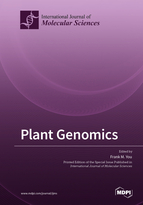Plant Genomics
A special issue of International Journal of Molecular Sciences (ISSN 1422-0067). This special issue belongs to the section "Molecular Plant Sciences".
Deadline for manuscript submissions: closed (30 November 2018) | Viewed by 134269
Special Issue Editor
Interests: plant bioinformatics; comparative genomics; genome evolution; quantitative genetics and statistical genomics; genetics and breeding; software tool and database development
Special Issues, Collections and Topics in MDPI journals
Special Issue Information
Dear Colleagues,
Genomics is a fast evolving field of genetics and molecular biology, focusing on the structure, function, evolution, mapping, and editing of genomes. Recent development of sequencing technologies and advances in bioinformatics tools have substantially enhanced our ability to analyze and understand genomes and the relationship between genotype and phenotype. The purpose of this Special Issue is to report the recent progress achieved in genomics studies in plants. This includes, but is not limit to, genetic and physical mapping, genome sequencing, genome structure and organization, genome assembly, gene prediction, comparative genomics, genome evolution, gene editing, SNP discovery, genome-wide association study, exome sequencing, RNA sequencing, expression profiling, the functions of specific genes, protein–protein interaction, pathways, epigenomics, and so on. In addition, reports on plant genomics leading to crop molecular breeding, such as marker-assisted selection and genomic selection are encouraged. The bioinfomratic tools and databases assisting genomic data analyses are also welcomed.
Dr. Frank M. You
Guest Editor
Manuscript Submission Information
Manuscripts should be submitted online at www.mdpi.com by registering and logging in to this website. Once you are registered, click here to go to the submission form. Manuscripts can be submitted until the deadline. All submissions that pass pre-check are peer-reviewed. Accepted papers will be published continuously in the journal (as soon as accepted) and will be listed together on the special issue website. Research articles, review articles as well as short communications are invited. For planned papers, a title and short abstract (about 100 words) can be sent to the Editorial Office for announcement on this website.
Submitted manuscripts should not have been published previously, nor be under consideration for publication elsewhere (except conference proceedings papers). All manuscripts are thoroughly refereed through a single-blind peer-review process. A guide for authors and other relevant information for submission of manuscripts is available on the Instructions for Authors page. International Journal of Molecular Sciences is an international peer-reviewed open access semimonthly journal published by MDPI.
Please visit the Instructions for Authors page before submitting a manuscript. There is an Article Processing Charge (APC) for publication in this open access journal. For details about the APC please see here. Submitted papers should be well formatted and use good English. Authors may use MDPI's English editing service prior to publication or during author revisions.
Keywords
- structural genomics
- functional genomics
- epigenomics
- mapping
- genome sequencing
- genome organization
- genome evolution
- marker development
- quantitative trait loci
- genome-wide association study
- genomic selection
- marker-assisted selection
- gene expression







